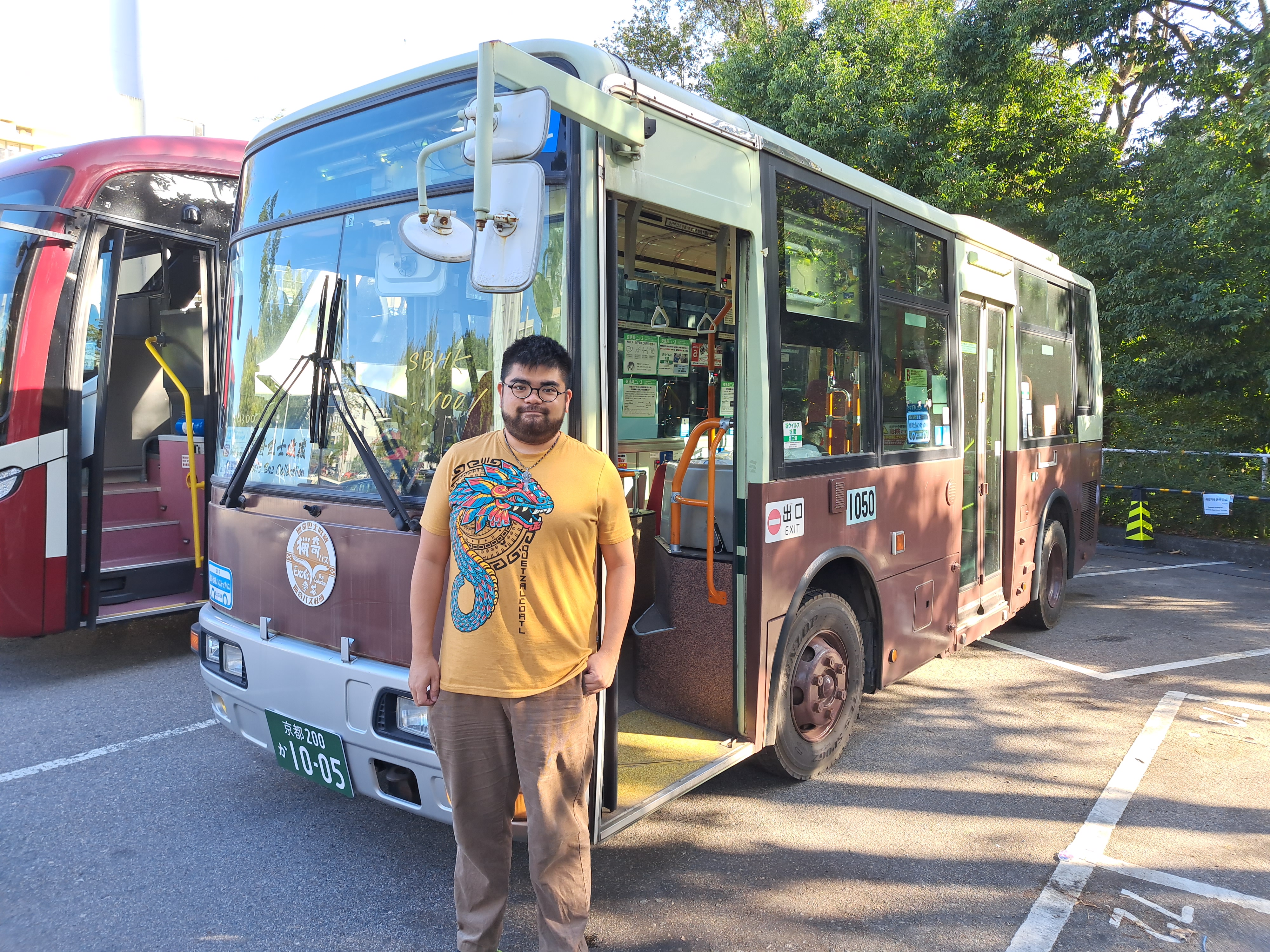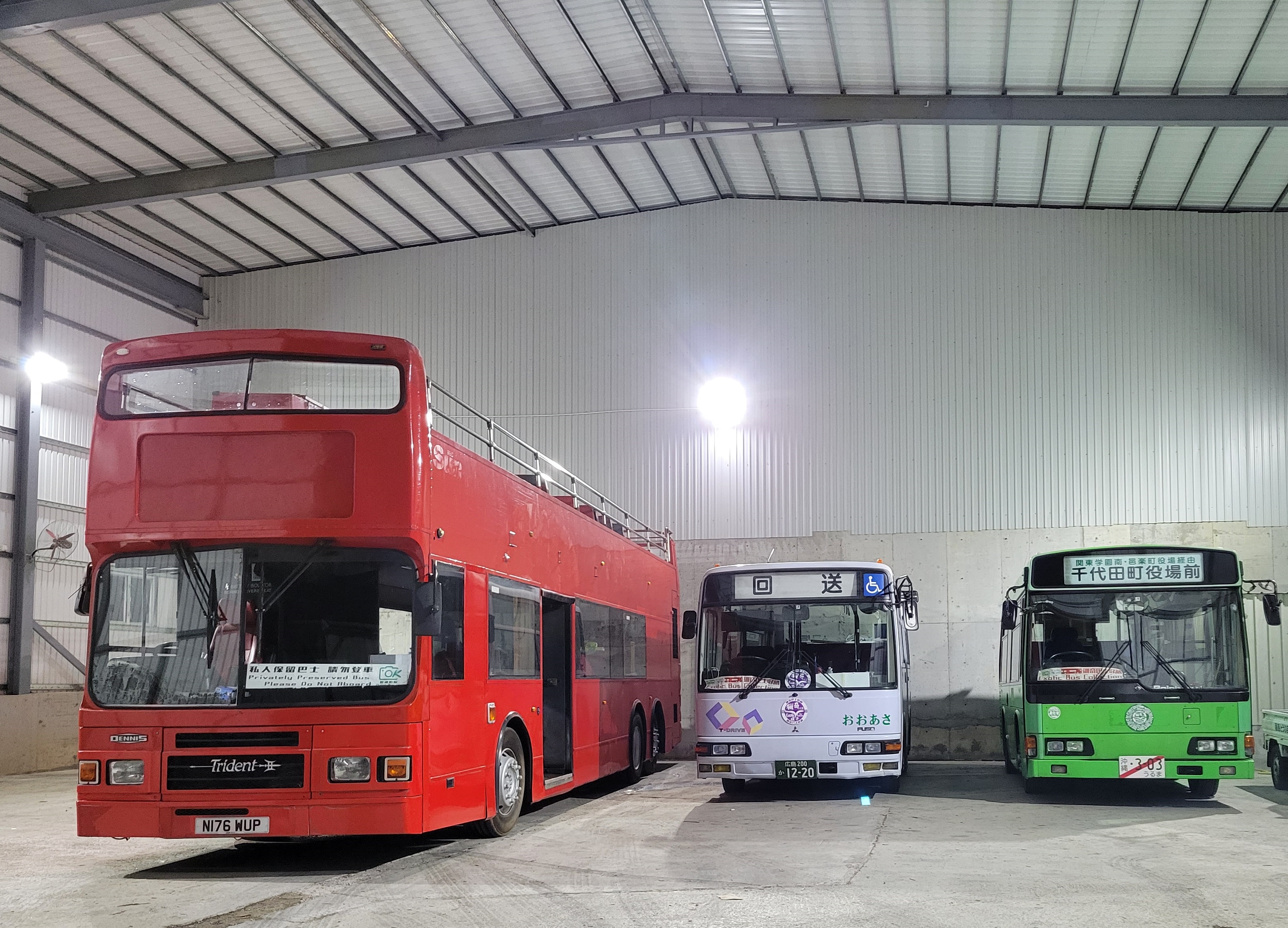Passion for conservation
anthropology alumnus Ophi Chow rekindles life in eight retired buses
Ophi Chow (19/GS/Anthropology) has nurtured a deep passion for archaeology and studying buses since childhood. In fact, during his secondary school years, he could identify bus models simply by listening to their engines. Four years ago, he chanced upon an opportunity to purchase his first retired bus and since then has been addicted to collecting them. Presently, he owns one British and seven Japanese buses, which create a unique spectacle in the local streets of Hong Kong. During this interview, Ophi drove his newly imported eighteen-year-old Kyoto bus around the CUHK campus, causing a stir among students who eagerly snapped photos with their mobile phones. Apart from bringing him a sense of satisfaction, this also promotes the idea of cultural conservation.
 Ophi Chow owns eight retired buses, including this latest arrival in Hong Kong, an 18-year-old narrow-bodied Kyoto bus named “Barley Tea”.
Ophi Chow owns eight retired buses, including this latest arrival in Hong Kong, an 18-year-old narrow-bodied Kyoto bus named “Barley Tea”.
Enchantment with petite Japanese buses
Ophi recounted how the trend of preserving retired buses gained popularity in Hong Kong during the 1990s, a time when he was too young and lacked the financial means to acquire the vintage local buses he desired. After coming of age, his attention shifted to foreign buses. In 2019, he procured his first bus, a British open-top double-decker. Subsequently, he specialised in collecting Japanese buses. “European bus bodies and parts are often sourced from various manufacturers, whereas Japanese buses produced before 2000 were entirely made and assembled by the same automobile factories, resulting in a distinct Japanese appearance. The design of these buses reflects urban development, with railways being an integral part of Japanese society, and buses serving as supplementary transportation. Therefore, they tend to be smaller in size. Among all Japanese buses, my favourites are the petite buses, which are less than seven metres in length. They were originally designed to navigate narrow rural roads, featuring low floors to make it easier for elderly passengers to board and alight,” he said.
 The Dennis Trient open-top bus (left) is the first bus that Ophi purchased. Both “Grapes” (middle) and “Green Tea” (right) are Japanese petite buses produced in 2002.
The Dennis Trient open-top bus (left) is the first bus that Ophi purchased. Both “Grapes” (middle) and “Green Tea” (right) are Japanese petite buses produced in 2002.
With the production of minibuses in Japan already discontinued, he fears that these vehicles may eventually become extinct. As he cannot bear the thought of seeing them end up as scrap metal, he has been acquiring decommissioned buses mainly through middlemen and auction platforms. Each vehicle costs tens of thousands of Hong Kong dollars, with shipping fees amounting to nearly the same. However, maintenance and repairs present a significant challenge. “The engine and gearbox are the main issues, and finding suitable parts is arduous. Regular garages are reluctant to repair them. I can only slowly explore the problems with mechanics that I know well. Nowadays, we tend to opt for parts that are more readily available unless the aim is to preserve a rare model. For instance, this narrow-bodied Mitsubishi bus produced in 2005 shares the same engine as the same brand of Hong Kong minibuses,” he said.
 The double-decker bus “Mango” (left) is 32 years old this year while “Bai Hao” (right) was manufactured in 1979 and is the oldest bus in Ophi’s collection.
The double-decker bus “Mango” (left) is 32 years old this year while “Bai Hao” (right) was manufactured in 1979 and is the oldest bus in Ophi’s collection.
Different conservation rules between Hong Kong and Japan
Ophi’s bus collection consists of eight vehicles, with six being placed in Yuen Long upon their arrival in Hong Kong and two stored in Japan. He highlighted the disparity in regulations and fan culture between the two places. He said, “In Japan, decommissioned buses can be relicensed as private buses or even converted into camping vehicles or food trucks. In addition, there are frequent gatherings and exhibitions for bus enthusiasts. By comparison, retired buses in Hong Kong cannot be relicensed and can only be driven on the road with a trade plate, accommodating no more than two passengers. This is why they are primarily used for sightseeing or exhibition purposes. Nonetheless, preserving buses is not without its challenges. Once, I parked my bus on the roadside and left it unattended for a while. Someone falsely reported that there was a driver fainting on board. Fortunately, I came back in time as the firefighters were ready to break the glass.”
 Ophi holds a bus license and after attaching a trade plate, he could drive retired buses on the streets of Hong Kong.
Ophi holds a bus license and after attaching a trade plate, he could drive retired buses on the streets of Hong Kong.
Hongkongers love travelling to Japan. When Japanese buses are spotted on the streets of Hong Kong, their reactions are noticeably enthusiastic. “My goal is to promote the bus culture among Hongkongers and bring them new experiences. Many people admire me for being willing to devote energy and effort to conserving Japanese buses and this makes me feel gratified and fulfilled.” Although Ophi and local bus collectors have different preferences, they share the same passion towards preserving the bus culture. He even opened an “exotic bus collection” page on social media. “They are preserving collective local memories, while I focus more on preserving the industrial and mechanical designs of buses from different eras, hoping to let more bus enthusiasts learn about retired buses with different national characteristics.”
 Ophi lends the “Green Tea” bus to a friend for taking wedding photos and presents the couple with a “Happiness Station” bus-stop sign.
Ophi lends the “Green Tea” bus to a friend for taking wedding photos and presents the couple with a “Happiness Station” bus-stop sign.
Appreciation for historic architecture of CUHK
After graduating with a Bachelor of Arts in Conservation from the University of Hong Kong, Ophi enrolled in a Master of Anthropology programme at CUHK. “That’s because part of the Anthropology course curriculum is related to cultural conservation. Anthropology helps me understand people’s thoughts, which is useful when communicating with individuals of diverse backgrounds in the process of collecting buses. The biggest inspiration I have gained from this course is witnessing numerous students who have already obtained several degrees continuing to pursue further education, demonstrating a true passion for learning.”
Celebrating its 60th anniversary, CUHK boasts a rich collection of historic relics. Ophi finds the diverse campus architectures of different periods most worthy of appreciation. “From the early buildings of Chung Chi College to the 'Gentleman Tower' and the 'Lady Tower' as well as the modern glass facades, the campus reflects the architectural styles of various eras. These buildings, along with Lake Ad Excellentiam, have created a beautiful hilly landscape for the university,” he said.
"CU Alumni Magazine" Video Interview: https://youtu.be/wdwFKN0_WX0(Chinese only)
Published in "CU Alumni Magazine" Issue 113 by Alumni Affairs Office 2023
Read online: CU Alumni Magazine Issue 113 (Chinese Version Only)
pdf version: http://alumni.cuhk.edu.hk/zh-Hant/magazine/categories/pdfversion/202303
ISSUU version: http://www.alumni.cuhk.edu.hk/magazine/issuu/





